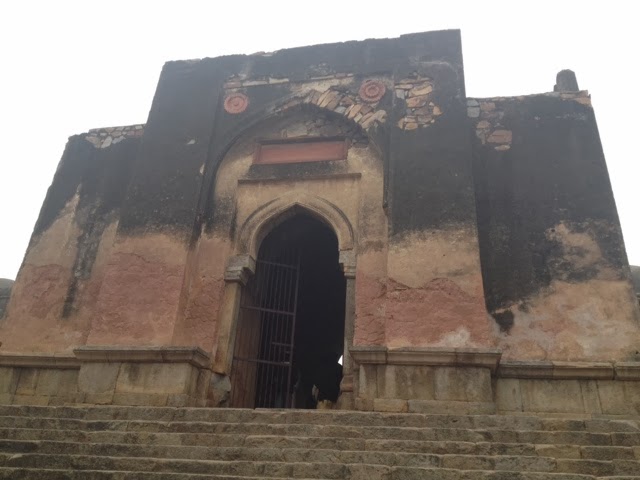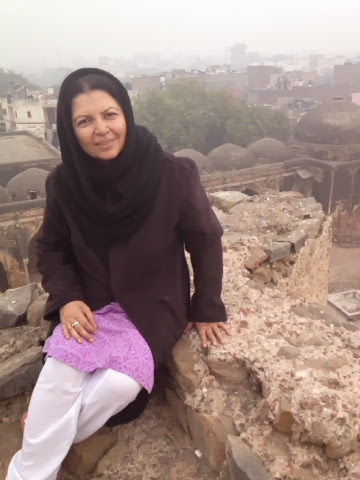By Rana Safvi,
From childhood i have been hearing a phrase
” Khandhar bata rahe hain ke imarat shaandar thi”
Today i was almost in tears at the ruin of a once magnificent place of worship and piece of architecture.
Begumpur is the Jami Masjid of Jahanpanah the 4th city of Delhi built by Ghiyasuddin Tughlaq.
This city didn’t last for long, some say because the water was brackish, while others say that Hazrat Nizamuddin Auliya, whom the ruler had aggravated had cursed it.
Today it lies in the heart of Delhi, near Malviya Nagar, in a state of neglect and disrepair.

The elevated entrance to this imposing, stark mosque.
Though Many historians and websites say that these mosques (or some of them) were built by Khan-i-Jahan Maqbool Tilangani (Malik Maqbool), The ASI Publication “Delhi and its Neighbourhood” says that “….the Begumpuri-Masjid,(is)….reputed to have been built by Khan-e-Jahan Juna Shah….” Even Sir Syed in his seminal work Asarus Sanadeed attributes the Begumpur Mosque to Khan e Jahan Ferozshahi ( Junior)
The famous mosques made by Telingani are:
* Khirki Mosque.
* Begampur Mosque.
* Masjid Kalu Sarai.
* Kalan Masjid (Hazrat Nizamuddin).
* Masjid Firoz Shah Kotla.
* Masjid Wakya (Lahori gate).
* Kalan Masjid (Turkaman gate).
There is a dispute whether Telingani was indeed the builder of these mosques but i am going with the public view.
Once inside the visitor is greeted by the sight of a huge courtyard with prayer corridors on three sides.

andheron men khanDar sotaa padaa hai
abaabiilon ke lashkar jaagte hain
The mosque measures 307ft by 295ft and included within its walls a madrasa and a treasury.

The central pishtaq is supported by pillons on both sides and houses the central mehrab.
In Islamic architecture, a rectangular frame around an arched opening, usually associated with an iwan, a vaulted space used as an entrance.

The mehrab : the only part of the mosque in some semblqnce of order ans maintenance.
Till 1921 there were villagers living inside along with their cattle. In 1921 the ASI evacuated them but they continued to use it as a dumping ground and as a toilet and the state of disrepair bears testimony to it.

ye aur baat ki ‘aKHtar’ haveliyaa.n na rahiin
khanDar men kam to nahiin apnii aabruu raushan
It has been built in the austere style of rubble masonry. Sir Syed describes it as strong and ugly . No doubt it is sans any embellishment we are used to seeing in medieval buildings but there is a grandeur in its starkness to me.

Some of the walls have fallen to let the sun in

har shaKHs yahaan gumbad-e-be-dar kii tarah hai
aavaaz pe aavaaz do suntaa nahiin koii
The mosque contains 64 domes, with one central one with a height of 9ft.

The domes today afford a place for lOcals to hang out in and at dusk to ‘party’.

khaDaa huun zer-e-falak gumbad-e-sadaa men ‘muniir’
ke jaise haath uThaa ho koii duaa ke liye
On the roof.

A view from the top. The five domes in the rear belong to the ladies mosque
The Begumpur Mosque is known as the first Indian example of the “Brhatmukhi” mosque type: at the center of the 24 arches on its main façade, an extremely large arch stands out, flanked by massive tapering pylon-minarets.

Resting after the climb up the steep, narrow and dark stairs to the roof

Up close with the main dome

This is the mehrab in the Mullah Khana : possibly a rare ladies mosque attached to Begumpur. Unfortunately its used as a toilet by the locals. I had to cover my nose to overcome the stench there and having failed to see clearly in the dark stepped on filth and dirtied my shoes.

What was once a mehrab now bears testimony to some Raakhee’s self obsession or her admirer’s stupidity.

The inside of the ladies mosque.
I cannot describe my feelings at seeing such deep dosdain for our architectural heritage and magnificent places of worship.

A mute spectator to what must have once been glory days
—-
Rana Safvi is founder of #shair on twitter. her twitter handle is @iamrana
